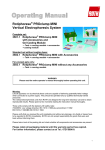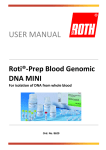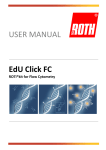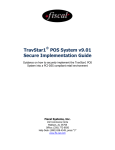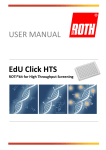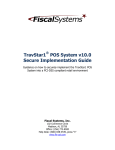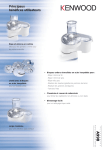Download User manual / Technical Information
Transcript
USER MANUAL Roti®-Prep Viral DNA/RNA MINI For isolation of viral DNA and RNA from various sources Ord. No. 8547 Roti®-Prep Viral DNA/RNA MINI Carl Roth GmbH + Co. KG Roti®-Prep Viral DNA/RNA MINI For isolation of viral DNA and RNA from a variety of sample materials Introduction and product description: Preparation by well-known mini spin-column system Fast, easy and efficient For isolation of viral ssDNA, dsDNA and ssRNA Preparation in approx. 25 minutes Elution in 60 µl Roti®-Prep Viral RNA/DNA MINI has been developed for the isolation of viral DNA and RNA from various kinds of source material. The isolation is carried out via the proven and reliable spin column technique, which is very easy to handle and needs only few steps. The kit enables the simultaneous extraction of viral ssDNA, dsDNA and ssRNA. The purification happens by using a carrier RNA, which engenders a higher binding of the nucleic acid (resp. its complex with the carrier RNA) on the spin filter and thus a higher recovery rate. Furthermore, in order to achieve a maximum of nucleic acid purity for each source material, 5 specifically optimised protocols are provided. Thus, within approx. 25 mins. high-pure viral nucleic acid is eluted, free from inhibitors, for further downstream applications, like RT-PCR, PCR, packaging etc. The Kit has been successfully tested for e.g. HBV, CMV, EBV, HSV, FMDV. Suitable source material: Tissue (up to 20 mg) Biopsies (up to 20 mg) Supernatant medium from cell culture (up to 400 µl) Serum, plasma or liquor (up to 400 µl) Cell-free body fluids (up to 400 µl) Swabs For research use only. Information in this document is subject to change without notice. Carl Roth GmbH + Co. KG assumes no responsibility for any errors that may appear in this document. Carl Roth GmbH + Co. KG disclaims all warranties with respect to this document, expressed or implied, including but not limited to those of merchantability or fitness for a particular purpose. In no event shall Carl Roth GmbH + Co. KG be liable, whether in contract, tort, warranty, or under any statute or on any other basis for special, incidental, indirect, punitive, multiple or consequential damages in connection with or arising from this document, including but not limited to the use thereof. Roti®-Prep Viral DNA/RNA MINI Carl Roth GmbH + Co. KG Cautions: Binding Buffer BSN Lysis Buffer LSV* Proteinase K Washing Buffer WSA Danger H225-H318-H336-H411 P210-P280-P303+P361+P353-P305+P351+P338-P312 Danger H318 P280-P305+P351+P338-P310 Danger H315-H319-H334-H317-H335 P280-P284-P333+P313-P337+P313-P342+P311 Warning H302+H332-H412-EUH032 P301+P312-P304+P340 *In case of forming of precipitates, please dissolve by careful warming. MSDS: the appropriate MSDS can be downloaded from our website www.carlroth.com. All due care and attention should be exercised in handling the materials and reagents contained in the kit. Always wear gloves while handling these reagents and avoid any skin contact! In case of contact, flush eyes or skin with a large amount of water immediately. Research samples gained from patient’s material like serum, liquor etc. sample must always be considered as potentially infectious. Samples from risk patients must always be labelled and handled under consequent safety conditions. Please observe the federal, state and local safety and environmental regulations. Literature Citation: When describing a procedure for publication using this product, please refer to it as Carl Roth’s Roti®-Prep Viral DNA/RNA MINI Kit. 1. Materials provided with the kit and storage conditions Amount 30 mg 25 ml 60 ml 0.5 mg 3x2 ml 15 ml 16 ml 50 50 6x50 Component Proteinase K Lysis Buffer LSV Binding Buffer BSN Carrier CS (Base) RNase-free water Washing Buffer WSA (Base) Washing Solution WSL (Base) Mini spin columns (blue) 1.5 ml Elution tubes 2 ml Collection tubes 3 Storage +4 °C / -20 °C* >20 °C** RT -20 °C*** RT RT RT RT RT RT Carl Roth GmbH + Co. KG Roti®-Prep Viral DNA/RNA MINI * Lyophilized Proteinase K should be stored at +4 °C. Prior to use, dissolve Proteinase K in 1.5 ml sterile, distilled water as given below. Dissolved Proteinase K should be stored in aliquots at -20 °C. Avoid repeated freeze&thaw cycles for each tube. ** Lysis Buffer should be stored at over 20 °C in order to prevent precipitation of reagents. *** Lyophilized Carrier CS should be stored at -20 °C after receipt of the Kit. Prior to use, dissolve Carrier CS in 1.25 ml sterile, RNase-free water as given below. Dissolved Carrier CS should be stored in aliquots at -20 °C. Avoid repeated freeze&thaw cycles for each tube. Mixture of Lysis Buffer LSV and Carrier CS is stable for one day at +4 °C. The Roti®-Prep Viral DNA/RNA MINI Kit should be stored dry, at room temperature (14-25 °C). Before every use make sure that all components have room temperature. If there are any precipitates within the provided solutions solve these precipitates by careful warming. This kit is stable for at least 6 months after receipt, when stored as directed. Contents of this Kit may not be bought separately. The components of each Roti®-Prep Viral DNA/RNA MINI Kit were tested in general by isolation of viral DNA and RNA and subsequent detection of the internal control DNA and RNA by real-time PCR. The user is responsible, however, to validate the performance of the Roti®-Prep Viral DNA/RNA MINI Kit for isolation of RNA from his particular samples, since the performance characteristics of our kits have not been validated for any specific application. 2. Required Material and Equipment not included in this kit Ethanol 96-99.8 %, e.g. Ethanol p.a. (e.g. 9065.1) Distilled, sterilized H2O, DNase-free (e.g. HN57.1, sterilize in an autoclave) Distilled, sterilized H2O, RNase-free, for preparation of 70 % ethanol, (e.g. T143.1) 1x PBS, DNase-free or RNase-free (e.g. Roti®-Stock 10x PBS, 1059.1) 0.9 % NaCl solution, RNase-free (e.g. HN00, NaCl, powdered, CELLPURE®, with low endotoxin content) DEPC (e.g. K028.1) 3. Application Roti®-Prep Viral DNA/RNA MINI is designed for isolation of high-purity viral DNA and/or RNA from various source material. Spin column based preparation allows elution in a small volume of low-salt buffer, eliminating time-consuming phenol-chloroform extraction or alcohol precipitation. The columns may be used either in micro-centrifuges or on vacuum manifolds. The detection limit for certain viruses depends on the individual procedures, for example inhouse PCR or commercial detection assays used. The Roti®-Prep Viral DNA/RNA MINI kit contains a Carrier Mix (Carrier CS) with Carrier RNA as well as an internal control (IC) DNA and RNA. This IC DNA/RNA may be used for checking the success of DNA/RNA isolation by real-time PCR. Use of the Carrier CS is optional. 4 Roti®-Prep Viral DNA/RNA MINI Carl Roth GmbH + Co. KG Please note that in case of using the Carrier CS the eluate contains isolates viral nucleic acids as well as IC DNA/RNA and Carrier RNA. In this case, quantitation of the isolated nucleic acids by photometric or fluorometric methods is not possible. We recommend to quantify extracted DNA and RNA by other methods like specific quantitative PCR or real-time PCR. Additionally, Carrier RNA may inhibit PCR reactions. Thus, the amount of Carrier RNA added has to be carefully optimized depending on the individual PCR system used for down-stream analyses. As in all isolation procedures, lysis is a crucial step and has to be performed very carefully. Complete lysis of the sample is vital for a good recovery rate of nucleic acid. Generally, virus lysis is easily achieved under the conditions given in the protocols. However, if the recovery rate is not as good as expected, lysis conditions may have to optimised nevertheless. Please focus on the fact that RNA is highly temperature sensitive and has to be kept cool as soon as possible. It is important, therefore, to prolong all steps as long as necessary, but also as short as possible. The lysed samples may be stored prior to adding the Binding Buffer. Store samples of RNAvirions at -80 °C and samples of DNA virions at -20 °. Repetition of elution (final step) may the recovery rate overall. However, even so often, concentration of the recovered RNA is reduced in parallel, since the whole amount of water used for elution is higher. Store the extracted DNA at -20 °C, extracted RNA at -80 °C. Avoid repeated freeze & thaw cycles by all means. For centrifugation we recommend a standard microcentrifuge. Centrifugation steps should be carried out at room temperature. Avoid repeated freeze&thaw cycles for the tissue to be extracted. All materials and reagents used for DNA or RNA isolation should be free of DNases or RNases. 4. General Comments on Handling of RNA RNA is far less stable than DNA. It is very sensitive to degradation by endogenous RNases in the biological material and exogenous RNases which are permanently present everywhere in the lab. In order to achieve satisfactory qualitative and quantitative results in RNA preparations, contaminations with exogenous RNases have to be reduced to a minimum in accordance with the following recommendations: Clear the bench top first using RNase AWAY® (A998.1) or Roti®-Nucleic Acid-free (HP69.1). Always wear latex or vinyl gloves while handling reagents and RNA samples in order to prevent RNase contaminations from surface of the skin or from dusty laboratory equipment. 5 Carl Roth GmbH + Co. KG Roti®-Prep Viral DNA/RNA MINI Use only sterile, disposable polypropylene tubes throughout the procedure (these tubes are generally RNase-free.) Autoclaving will not inactivate RNases. Non-disposable plastic ware should be treated before use to ensure that it is RNase-free. Plastic ware should be thoroughly rinsed with RNase AWAY® (A998.1) or Roti®-Nucleic Acid-free (HP69.1), followed by RNase-free water. All glassware should be treated before use in order to ensure that it is RNase-free. Glassware should be cleaned with RNase AWAY® (A998.1) or Roti®-Nucleic Acid-free (HP69.1), thoroughly rinsed with RNase-free water, and oven baked at 240 °C for four or more hours before use. Oven baking in-activates RNases and ensures that no other nucleic acids (such as plasmid DNA) are present on the surface of the glassware. Reduce preparation time as much as possible. Change gloves frequently and keep tubes closed. Keep isolated RNA on ice. Electrophoresis tanks should be cleaned with RNase AWAY® (A998.1) or Roti®-Nucleic Acid-free (HP69.1), followed by RNase-free water, rinsed with ethanol and finally allowed to dry. All buffers have to be prepared with DEPC-treated RNase-free double-distilled water. Avoid handling bacterial cultures, cell cultures or other biological sources of RNases in the same lab where the RNA purification will be performed. Do not use equipment, glassware and plastic ware employed for other applications which might introduce RNase contaminations in the RNA isolation. Before start, be sure to - Add Ethanol (96-99.8 %, not incl. in this kit) to the Washing Buffer WSA as follows: 8547.1 (50 Preps): 15 ml (30 ml final vol.) Mix thoroughly and keep the bottle always firmly closed! - Add Ethanol (96-99.8 %, not incl. in this kit) to the Washing Solution WSL as follows: 8547.1 (50 Preps): 64 ml (80 ml final vol.) Mix thoroughly and keep the bottle always firmly closed! - Dissolve Proteinase K by addition of cold, distilled, sterile, RNase-free H2O as follows: 8547.1 (50 Preps): 1.5 ml Mix thoroughly! - Dissolve Carrier CS by addition of cold, distilled, sterile, RNase-free H2O as follows: 8547.1 (50 Preps): 1.25 ml Mix thoroughly by pipetting. Dissolved Carrier CS should be stored in aliquots at -20 °C. Do not repeatedly freeze&thaw (3times in maximum). 6 Roti®-Prep Viral DNA/RNA MINI Carl Roth GmbH + Co. KG - Add the appropriate amount of Carrier CS to an aliquot of Lysis Buffer LSV: Lysis Buffer/Carrier Mix for isolation of nucleic acid from 200 µl cell-free fluid Component 1 sample 4 samples 10 samples Lysis Buffer LSV 240 µl 960 µl 2.4 ml Carrier CS 12 µl 48 µl 120 µl Final vol. 252 µl 1008 µl 2,52 ml Lysis Buffer/Carrier Mix for isolation of nucleic acid from 400 µl cell-free fluid Component 1 sample 4 samples 10 samples Lysis Buffer LSV 480 µl 1920 µl 4.8 ml Carrier CS 12 µl 48 µl 120 µl Final vol. 492 µl 1968 µl 4.92 ml Mixture of Lysis Buffer LSV and Carrier CS is stable for one day at +4 °C. - Heat one thermal mixer or water bath to 50 °C. - Preheat one tube of RNase-free water to 70 °C. Please note: Centrifugation steps should be carried out at room temperature 5. Workflow The workflow has been provided on a separate page, in order to use a copy for in-process protocol or filing in your personal lab files. 7 Carl Roth GmbH + Co. KG Roti®-Prep Viral DNA/RNA MINI 5.1 Isolation of viral DNA/RNA from 200 µl cell-free fluids Step (RT = room temperature) done 1. Virion Lysis Pipet 200 µl Mix of Lysis Buffer LSV/Carrier CS into a 2.0 ml reaction tube. Add 200 µl of the sample and 20 µl Proteinase K solution. Mix vigorously by pulsed vortexing for 10 sec. Incubate at 70 °C under constant agitation* for 10 mins. Centrifuge the lysed sample at 10.000 g (or 12.000 rpm) for 30 sec to remove condensate from the lid of the tube. Add 400 µl Binding Buffer BSN to the lysed sample. Mix by vortexing or pipetting until a homogenous solution is achieved. 2. Column Loading Place each blue Spin Column into a 2 ml collection tube Apply the mix of lysed sample/Binding Buffer BSN to the spin column. Centrifuge at 10.000 g (or 12.000 rpm) for 1 min/RT and discard the flow-through.** 3. Column Washing Place the Spin Column into a new collection tube. Add 500 µl of Washing Buffer WSA to the Spin Column Centrifuge at 10.000 g (or 12.000 rpm) for 1 min/RT and discard the flow-through** Add 650 µl of Washing Solution WSL to the Spin Column Centrifuge at 10.000 g (or 12.000 rpm) for 1 min/RT and discard the flow-through** Add 650 µl of Washing Solution WSL to the Spin Column Centrifuge at 10.000 g (or 12.000 rpm) for 1 min/RT and discard the flow-through** Again centrifuge columns at 10.000 g (or 12.000 rpm) for 5 mins/RT in order to remove residual ethanol. 5. Elution Place the Spin Column into a clean 1.5 ml elution tube Add 60 µl pre-heated DNase-free or RNase-free water (incl. in the kit) to the centre of the membrane*** Incubate for 2 mins at room temperature Centrifuge at 8.000 g (or 10.000 rpm) for 1 min/RT to elute DNA/RNA * We recommend using a shaking platform or thermomixer for continuous agitation of the sample. Alternatively, vortex the sample 3-4 times during incubation. Agitation is vital for a decent recovery rate. ** If the solution has not completely passed through the spin column, centrifuge again at higher speed or prolong the centrifugation time. *** The type of water to be used depends on whether viral DNA or viral RNA shall be isolated. Elution with lower volumes of water (e.g. 20-30 µl) increases the final concentration of DNA/RNA. Higher volumes (80-100 µl) result in lower concentration of DNA/RNA, although the overall amount of DNA/RNA eluted may be slightly higher. Repetition of the elution step may increase the yield of DNA/RNA overall, but may reduce the concentration after pooling of the fractions. Minimum elution amount is 20 µl. 8 Roti®-Prep Viral DNA/RNA MINI Carl Roth GmbH + Co. KG 5.2 Isolation of viral DNA/RNA from 400 µl cell-free fluids Step (RT = room temperature) done 1. Virion Lysis Pipet 400 µl Mix of Lysis Buffer LSV/Carrier CS into a 2.0 ml reaction tube. Add 400 µl of the sample and 20 µl Proteinase K solution. Mix vigorously by pulsed vortexing for 10 sec. Incubate at 70 °C under constant agitation* for 10 mins. Centrifuge the lysed sample at 10.000 g (or 12.000 rpm) for 30 sec to remove condensate from the lid of the tube. Add 800 µl Binding Buffer BSN to the lysed sample. Mix by vortexing or pipetting until a homogenous solution is achieved. 2. Column Loading Place each blue Spin Column into a 2 ml collection tube Apply 650 µl of the mix of lysed sample/Binding Buffer BR to the spin column. Centrifuge at 10.000 g (or 12.000 rpm) for 1 min/RT and discard the flow-through.** Apply residual mix of lysed sample/Binding Buffer BR to the spin column. Centrifuge at 10.000 g (or 12.000 rpm) for 1 min/RT and discard the flow-through.** 3. Column Washing Place the Spin Column into a new collection tube. Add 500 µl of Washing Buffer WSA to the Spin Column Centrifuge at 10.000 g (or 12.000 rpm) for 1 min/RT and discard the flow-through** Add 650 µl of Washing Solution WSL to the Spin Column Centrifuge at 10.000 g (or 12.000 rpm) for 1 min/RT and discard the flow-through** Add 650 µl of Washing Solution WSL to the Spin Column Centrifuge at 10.000 g (or 12.000 rpm) for 1 min/RT and discard the flow-through** Again centrifuge columns at 10.000 g (or 12.000 rpm) for 5 mins/RT in order to remove residual ethanol. 5. Elution Place the Spin Column into a clean 1.5 ml elution tube Add 60 µl pre-heated DNase-free or RNase-free water (incl. in the kit) to the centre of the membrane*** Incubate for 2 mins at room temperature Centrifuge at 8.000 g (or 10.000 rpm) for 1 min/RT to elute DNA/RNA * We recommend using a shaking platform or thermomixer for continuous agitation of the sample. Alternatively, vortex the sample 3-4 times during incubation. Agitation is vital for a decent recovery rate. ** If the solution has not completely passed through the spin column, centrifuge again at higher speed or prolong the centrifugation time. *** The type of water to be used depends on whether viral DNA or viral RNA shall be isolated. Elution with lower volumes of water (e.g. 20-30 µl) increases the final concentration of DNA/RNA. Higher volumes (80-100 µl) result in lower concentration of DNA/RNA, although the overall amount of DNA/RNA eluted may be slightly higher. Repetition of the elution step may increase the yield of DNA/RNA overall, but may reduce the concentration after pooling of the fractions. Minimum elution amount is 20 µl. 9 Carl Roth GmbH + Co. KG Roti®-Prep Viral DNA/RNA MINI 5.3 Isolation of viral DNA/RNA from tissue samples or biopsies (max. 20 mg ) Step (RT = room temperature) done 1a. Tissue Lysis with a Homogeniser Place max. 20 mg of the tissue sample (fresh or frozen material) into a suitable vessel for homogenisation. Add 200-500 µl DNase-free or RNase-free buffer (water or PBS), and homogenise the sample to fine powder according to instructions accompanying the instrument used. Transfer the homogenised tissue / buffer mix to a 1.5 ml reaction tube. Centrifuge the mixture at 15.000 g (or maximum speed) for 2 mins in order to remove unhomogenised material. 1b.Tissue Lysis with Mortar and Pestle in Liquid Nitrogen Place max. 20 mg of the tissue sample (fresh or frozen material) into a suitable vessel for grinding (e.g. a mortar). When using fresh material: add liquid nitrogen for freezing. Grind the sample with a pestle to fine powder. Add 200-500 µl DNase-free or RNase-free buffer (water or PBS) and mix thoroughly. Transfer the homogenised sample to a 1.5 ml reaction tube. Centrifuge the mixture at 15.000 g (or maximum speed) for 2 mins in order to remove unhomogenised material. 2. Virion Lysis Pipet 200 µl Mix of Lysis Buffer LSV/Carrier CS into a 1.5 ml reaction tube. Add 200 µl of the supernatant of the centrifuged sample. Also add 20 µl Proteinase K solution. Mix vigorously by pulsed vortexing for 10 sec. Incubate at 70 °C under constant agitation* for 10 mins. Centrifuge the lysed sample at 10.000 g (or 12.000 rpm) for 30 sec to remove condensate from the lid of the tube. Add 400 µl Binding Buffer BSN to the lysed sample. Mix by vortexing or pipetting until a homogenous solution is achieved. 3. Column Loading Place each blue Spin Column into a 2 ml collection tube Apply the mix of lysed sample/Binding Buffer BSN to the spin column. Centrifuge at 10.000 g (or 12.000 rpm) for 1 min/RT and discard the flow-through.** 3. Column Washing Place the Spin Column into a new collection tube. Add 500 µl of Washing Buffer WSA to the Spin Column Centrifuge at 10.000 g (or 12.000 rpm) for 1 min/RT and discard the flow-through** Add 650 µl of Washing Solution WSL to the Spin Column Centrifuge at 10.000 g (or 12.000 rpm) for 1 min/RT and discard the flow-through** Add 650 µl of Washing Solution WSL to the Spin Column Centrifuge at 10.000 g (or 12.000 rpm) for 1 min/RT and discard the flow-through** Again centrifuge columns at 10.000 g (or 12.000 rpm) for 5 mins/RT in order to remove residual ethanol. 10 Roti®-Prep Viral DNA/RNA MINI Carl Roth GmbH + Co. KG Sequel: Isolation of viral DNA/RNA from tissue samples or biopsies Step (RT = room temperature) done 5. Elution Place the Spin Column into a clean 1.5 ml elution tube Add 60 µl pre-heated DNase-free or RNase-free water (incl. in the kit) to the centre of the membrane*** Incubate for 2 mins at room temperature Centrifuge at 8.000 g (or 10.000 rpm) for 1 min/RT to elute DNA/RNA * We recommend using a shaking platform or thermomixer for continuous agitation of the sample. Alternatively, vortex the sample 3-4 times during incubation. Agitation is vital for a decent recovery rate. ** If the solution has not completely passed through the spin column, centrifuge again at higher speed or prolong the centrifugation time. *** The type of water to be used depends on whether viral DNA or viral RNA shall be isolated. Elution with lower volumes of water (e.g. 20-30 µl) increases the final concentration of DNA/RNA. Higher volumes (80-100 µl) result in lower concentration of DNA/RNA, although the overall amount of DNA/RNA eluted may be slightly higher. Repetition of the elution step may increase the yield of DNA/RNA overall, but may reduce the concentration after pooling of the fractions. Minimum elution amount is 20 µl. 11 Carl Roth GmbH + Co. KG Roti®-Prep Viral DNA/RNA MINI 5.4 Isolation of viral DNA/RNA from swabs Step (RT = room temperature) done 1. Virion Lysis Place the swab into a 1.5 ml reaction tube and add 0.9 % NaCl solution (DNase- or RNase-free) so that the swab head is completely covered. Incubate at RT for 15 mins. Shake the swab vigorously. Then remove it from the tube by pressing the tip of the swab to the inner tube wall, in order to quantitatively squeezing the liquid from the cotton wool into the tube. This solution is the sample used in the following steps. Pipet 200 µl Mix of Lysis Buffer LSV/Carrier CS into a 1.5 ml reaction tube. Add 200 µl of the sample and 20 µl Proteinase K solution. Mix vigorously by pulsed vortexing for 10 sec. Incubate at 70 °C under constant agitation* for 10 mins. Centrifuge the lysed sample at 10.000 g (or 12.000 rpm) for 30 sec to remove condensate from the lid of the tube. Add 400 µl Binding Buffer BSN to the lysed sample. Mix by vortexing or pipetting until a homogenous solution is achieved. 2. Column Loading Place each blue Spin Column into a 2 ml collection tube Apply the mix of lysed sample/Binding Buffer BSN to the spin column. Centrifuge at 10.000 g (or 12.000 rpm) for 1 min/RT and discard the flow-through.** 3. Column Washing Place the Spin Column into a new collection tube. Add 500 µl of Washing Buffer WSA to the Spin Column Centrifuge at 10.000 g (or 12.000 rpm) for 1 min/RT and discard the flow-through** Add 650 µl of Washing Solution WSL to the Spin Column Centrifuge at 10.000 g (or 12.000 rpm) for 1 min/RT and discard the flow-through** Add 650 µl of Washing Solution WSL to the Spin Column Centrifuge at 10.000 g (or 12.000 rpm) for 1 min/RT and discard the flow-through** Again centrifuge columns at 10.000 g (or 12.000 rpm) for 5 mins/RT in order to remove residual ethanol. 5. Elution Place the Spin Column into a clean 1.5 ml elution tube Add 60 µl pre-heated DNase-free or RNase-free water (incl. in the kit) to the centre of the membrane*** Incubate for 2 mins at room temperature Centrifuge at 8.000 g (or 10.000 rpm) for 1 min/RT to elute DNA/RNA * We recommend using a shaking platform or thermomixer for continuous agitation of the sample. Alternatively, vortex the sample 3-4 times during incubation. Agitation is vital for a decent recovery rate. ** If the solution has not completely passed through the spin column, centrifuge again at higher speed or prolong the centrifugation time. *** The type of water to be used depends on whether viral DNA or viral RNA shall be isolated. Elution with lower volumes of water (e.g. 20-30 µl) increases the final concentration of DNA/RNA. Higher volumes (80-100 12 Roti®-Prep Viral DNA/RNA MINI Carl Roth GmbH + Co. KG µl) result in lower concentration of DNA/RNA, although the overall amount of DNA/RNA eluted may be slightly higher. Repetition of the elution step may increase the yield of DNA/RNA overall, but may reduce the concentration after pooling of the fractions. Minimum elution amount is 20 µl. 13 Carl Roth GmbH + Co. KG Roti®-Prep Viral DNA/RNA MINI 6. Trouble Shooting Problem / probable cause Clogged spin filter Comments and suggestions Insufficient lysis and/or too much starting material Increase lysis time or centrifugation speed. After lysis centrifuge the lysate to pellet unlysed material. Continue with the supernatant. Check whether the protocol for virus lysis has been applied. Reduce amount of starting material. Overload of filters reduces yield. Low recovery / amount of isolated nucleic acid Insufficient lysis See above Incomplete elution Prolong incubation time with DNase-free or RNase-free water to 5 minutes, or repeat elution step once again. Use higher volume of DNase-free / RNase-free water for elution. Insufficient mixing with Binding Buffer Mix sample with Binding Buffer BSN by pipetting BSN or by vortexing prior to transfer of the sample onto the Spin Filter Low concentration of isolated nucleic acid Too much RNase-free Water Elute the viral DNA/RNA with a lower volume of DNase-free / RNase-free water. No Carrier CS added Add Carrier RNA (Carrier CS) to the sample as described above. Degraded RNA RNA source inappropriately handled or stored See above. Check condition of the starting material. Is it fresh and undamaged? RNA is very temperature sensitive. Make sure the protocol, especially the first steps, are performed as long as necessary, but as short as possible. RNase contamination of solutions, Use sterile, RNase-free filter tips. Before every Collection Tubes, etc. preparation clean up the pipette, the devices and the working place. Always wear gloves! Old material Use fresh material. Check and improve storage conditions. Incorrect storage of starting material. Avoid repeated freezing and thawing of the starting material. Viral RNA does not perform well in downstream applications (e.g. RT-PCR) Ethanol carryover during elution Increase time for removing of ethanol Salt carryover during elution Ensure that Washing Buffer WSA and Washing Solution WSL are at room temperature. Check Washing Solutions for salt precipitates. Dissolve these by careful warming. 14 Roti®-Prep Viral DNA/RNA MINI Carl Roth GmbH + Co. KG Your notes: 15 Carl Roth GmbH + Co. KG Roti®-Prep Viral DNA/RNA MINI Ordering information: (for detailed kit content see Table under 1.) Product number Product Content Amount 8547.1 Roti®-Prep Viral DNA/RNA MINI 1 Kit 50 Preps To place your order, please contact us: Phone (Germany): 0800/56 99 000 Phone (international): +49 (0)721/5606-0 Fax (Germany and international): +49 (0)721/5606-149 E-Mail (Germany): [email protected] E-Mail (international): [email protected] 16 Carl Roth GmbH + Co. KG Phone: +49 (0)721/5606-0 Schoemperlenstraße 3-5 Fax: 76185 Karlsruhe, Germany Email: [email protected] +49 (0)721/5606-149



















